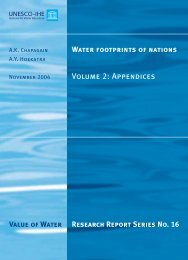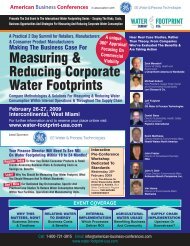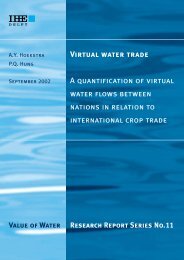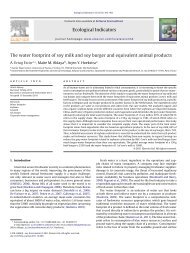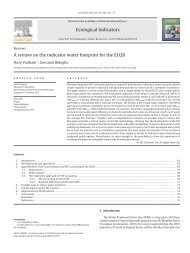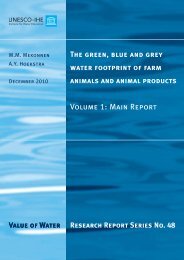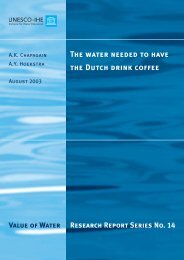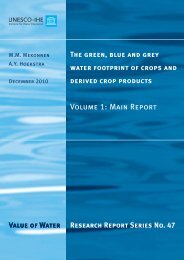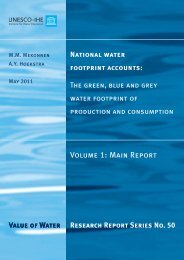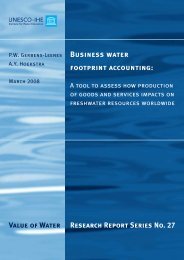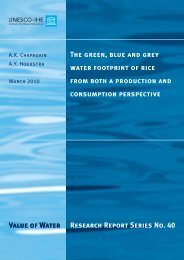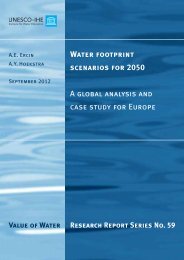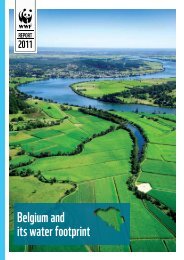Page set-up
Page set-up
Page set-up
- No tags were found...
You also want an ePaper? Increase the reach of your titles
YUMPU automatically turns print PDFs into web optimized ePapers that Google loves.
S. VermaD.A. KampmanP. van der ZaagA.Y. HoekstraMarch 2008Going against the flow:A critical analysis of virtualwater trade in the context ofIndia's National River LinkingProgrammeValue of WaterResearch Report Series No. 31
GOING AGAINST THE FLOWA CRITICAL ANALYSIS OF VIRTUAL WATER TRADE IN THE CONTEXT OFINDIA’S NATIONAL RIVER LINKING PROGRAMMESHILP VERMA 1, 2 *DOEKE A. KAMPMAN 3PIETER VAN DER ZAAG 2, 4ARJEN Y. HOEKSTRA 3MARCH 2008VALUE OF WATER RESEARCH REPORT SERIES NO. 311 International Water Management Institute (IWMI), India2 Dept. of Management and Institutions, UNESCO-IHE, Delft, the Netherlands3 Dept. of Water Engineering and Management, University of Twente, the Netherlands4 Water Resources Section, Delft University of Technology, Delft, the Netherlands* Contact author: Shilp Verma, e-mail: s.verma@unesco-ihe.orgThe Value of Water Research Report Series is published byUNESCO-IHE Institute for Water Education, Delft, the Netherlandsin collaboration withUniversity of Twente, Enschede, the Netherlands, andDelft University of Technology, Delft, the Netherlands
ContentsSummary.................................................................................................................................................................51. Introduction: India’s National River Linking Programme..................................................................................72. Virtual water trade and international trade theories..........................................................................................113. Inter-state virtual water trade in India: Quantum and direction........................................................................134. Determinants of inter-state virtual water trade in India ....................................................................................175. Discussion: Why H-O does not work for H 2 O..................................................................................................236. Conclusions and implications for India’s National River Linking Programme................................................25Acknowledgements ..............................................................................................................................................27References ............................................................................................................................................................28
SummaryVirtual water trade has been promoted as a tool to address national and regional water scarcity. In the context ofinternational (food) trade, this concept has been applied with a view to optimize the flow of commoditiesconsidering the water endowments of nations. The concept states that water-rich countries should produce andexport water intensive commodities (which indirectly carry embedded water needed for producing them) towater-scarce countries, thereby enabling the water-scarce countries to divert their precious water resources toalternative, higher productivity uses.While progress has been made on quantifying virtual water flows between countries, there exists littleinformation on virtual water trade within large countries like India. This report quantifies and critically analyzesinter-state virtual water flows in India in the context of a large inter-basin transfer plan of the Government ofIndia.Our analysis shows that the existing pattern of inter-state virtual water trade is exacerbating scarcities in alreadywater scarce states and that rather than being dictated by water endowments, virtual water flows are influencedby other factors such as "per capita gross cropped area" and "access to secured markets". We therefore arguethat in order to have a comprehensive understanding of virtual water trade, non-water factors of production needto be taken into consideration.
1. Introduction: India’s National River Linking ProgrammeWater infrastructure projects have always caught the fancy of planners and policy makers around the world.From the Hoover dam in the United States to the Aswan dam in Egypt, Nurek in Tajikistan, Bakun in Malaysia,Tarbela in Pakistan, Itaipu in Brazil, and India’s Bhakra and Sardar Sarovar dams have been hailed as marvelsof modern society and have been a source of national pride to many. Pandit Jawaharlal Nehru, India’s firstPrime Minister, famously described the Bhakra Nangal project – independent India’s first large dam – as a “newtemple of resurgent India”. It is not surprising therefore that India has the third largest number of large dams inthe world, after China and the United States (Economist, 2003).Water transfers between river basins are at least as old as the Roman Civilization. However, the past century haswitnessed some exceptionally large inter basin water transfer (IBWT) schemes and plans. In all there existaround 155 IBWT schemes spanning 26 countries and with a total capacity to transfer around 490×10 9 m 3 /yr ofwater. In addition, there exist plans for around 60 proposed schemes with a total capacity to transfer 1,150×10 9m 3 /yr – almost three times the existing capacity! Eighty-two of the existing schemes – with a total capacity of178×10 9 m 3 /yr – are situated in North and South America; with Canada having the highest capacity of existingIBWT schemes at 138×10 9 m 3 /yr. Asia has 22 existing schemes with a total capacity of 181×10 9 m 3 /yr. Themajority of the rest lie in Europe (30 schemes; 120×10 9 m 3 /yr) with a lot fewer instances in Africa and Oceania(ICID, 2006).While somewhat similar plans in the United States and the former Soviet Union failed to take off, China’smassive South-North Water Transfer Project, with an estimated cost of US$ 50 billion, is perhaps the largest andcostliest water transfer project in the world. The Government of India, on directions from the S<strong>up</strong>reme Court in2002 and advice from the National Water Development Agency, plans to go a step further and has proposed anestimated US$ 120 billion National River Linking Programme (NRLP) which envisages linking 37 Himalayanand Peninsular rivers (Figure 1; NCIWRD, 1999). Doing this will form a gigantic south Asian water grid whichwill annually handle 178×10 9 m 3 /yr of inter-basin water transfer; build 12,500 km of canals; generate 34 Gigawattsof hydro-power; add 35 million ha to India’s irrigated areas and generate inland navigation benefits(IWMI, 2003; NWDA, 2006; G<strong>up</strong>ta and Van der Zaag, 2007).The prime motivation behind the grand plan is India’s growing concern about the need to produce additionalfood for its large and rapidly increasing population. The National Water Development Agency cites that Indiawill require about 450 million tonnes of food grains per annum to feed a population of 1.5 billion in the year2050 (NCIWRD, 1999) and in order to meet this requirement, it needs to expand its irrigation potential to 160million hectares, which is 20 million hectares more than the total irrigation potential without NRLP.Considering that large parts of the Ganga-Brahmaputra-Meghna basin face recurring floods and a number ofWestern and Peninsular states face severe droughts, the National Water Development Agency contends that“one of the most effective ways to increase the irrigation potential for increasing the food grain production,
8 / Going against the flow: Inter-state virtual water trade in Indiamitigate floods and droughts and reduce regional imbalance in the availability of water is the Inter Basin WaterTransfer (IBWT) from the surplus rivers to deficit areas” (NWDA, 2006).Figure 1. India’s proposed National River Linking Programme (NRLP), with the Himalayan component (left) andthe Peninsular component (right). Source: Reproduced from NCIWRD (1999).However, representatives from civil society, the media and academia have strongly criticized the plan (Iyer,2002; Vombatkere, 2003; Vaidyanathan, 2003; Bandyopadhyay and Perveen, 2004; Patkar, 2004). Besidesvoicing concerns about the potential negative environmental impacts of the mega-project, critics have arguedthat the decision to go ahead with the plan has been hasty. They argue that the NRLP is only one of thealternatives to ensure India’s food and water security and alternative – local, cheaper and greener – optionsshould have been given more serious consideration. A number of alternatives have been suggested includingdecentralized water harvesting and artificial recharge of aquifers, improving the productivity of agriculture inwater scarce regions (which, it is claimed, continue to waste precious water resources), improving the efficiencyof India’s public irrigation systems through involvement of stakeholders in the management of irrigation, andusing virtual water trade, instead of physical water transfers, to tackle the high spatial variation in wateravailability across the country.While a number of these options seem plausible, all of them require further scientific exploration and studybefore any one of them (or more than one, in combination) can form a feasible answer to India’s impending andformidable water crisis. While the Government of India has failed to share with the public its detailed studiesand plans for the proposed inter-basin transfers, the opponents of NRLP also do not have a studied programmeof action to present. The lack of such analyses has led to a polarized and opinionated debate which is preventingthe nation from forming a scientific opinion about the NRLP and its various alternatives (Verma and Phansalkar,2007).One of the alternatives to NRLP that has been discussed is virtual water trade within the country. Proponents ofthis alternative have argued that instead of physically transferring large quantities of water from the flood-prone
Going against the flow: Inter-state virtual water trade in India / 9east to the water scarce west and south, it would be desirable to transfer virtual water in the form of food grains.This report explores the factors that influence inter-state virtual water trade in India; provides a preliminaryassessment of the potential of virtual water trade to act as an alternative to the proposed IBWT; and assessespolicy options for promoting and enhancing water saving trade within the country (Verma and Van der Zaag2007; Verma, 2007).
2. Virtual water trade and international trade theoriesThe term ‘virtual water’ was introduced by Allan (1993, 1994) referring to the volume of water needed toproduce agricultural commodities. The same concept has differently been referred to as ‘embedded water’(Allan, 2003), ‘exogenous water’ (Haddadin, 2003) or ‘ultra-violet’ water (Savenije, 2004). When a commodity(or service) is traded, the buyer essentially imports (virtual) water used in the production of the commodity. Inthe context of international (food) trade, this concept has been applied with a view to optimize the flow ofcommodities considering the water endowments of nations. Using the principles of international trade, itsuggests that water-rich countries should produce and export water intensive commodities (which indirectlycarry embedded water needed for producing them) to water scarce countries, thereby enabling the water-scarcecountries to divert their precious water resources to alternative, higher productivity uses.The concept was later expanded to include other commodities and services (Allan 1998; Hoekstra, 2003).Several researchers (Hoekstra and Hung, 2002; Hoekstra, 2003; Chapagain and Hoekstra, 2003; Oki et al.,2003; Renault, 2003; Zimmer and Renault, 2003; Fraiture et al., 2004; Chapagain et al., 2005; Chapagain, 2006,Hoekstra and Chapagain 2007, 2008) have investigated the role that international trade in virtual water can playin attaining global water saving and in ensuring food security in regions facing acute physical and economicwater scarcity especially in the Middle East and North Africa region and in southern Africa.Chapagain and Hoekstra (2004) employed the concept of ‘water footprint’ to compute nations’ dependence onvirtual water in the global trade system. Hoekstra and Hung (2002, 2005) quantified the scale and extent ofvirtual water crop trade globally while Chapagain and Hoekstra (2003) developed the methodology for similarcalculations in the context of trade in livestock and livestock products. The two results were then combined toget a comprehensive picture of the total agricultural virtual water trade (Hoekstra and Chapagain 2007, 2008;Chapagain and Hoekstra 2008). Global water saving from this trade was estimated to be of the order of 455 Gm 3per annum (Oki et al. 2003; Oki and Kanae, 2004). However, policy conclusions from these results weresuitably moderated by Fraiture et al. (2004) who noted that global water savings are caused as a result ofproductivity differences between importing and exporting countries and are only an unintended by-product ofinternational trade in agricultural commodities. Following the same logic, it is also possible to argue that virtualwater trade can lead to wastage of water in the situation where countries with low water productivity exportvirtual water to high water productivity regions.While a lot has been said about the scope, benefits and limitations of virtual water trade between countries,studies on virtual water movement within countries are, at best, sparse. As mentioned above, for countries suchas India and China, it might be misleading to account for them as single entities. This is because even withinthese huge countries, there are wide disparities in water endowments. In addition, they demand special attentionsince while they are big players in the international food trade, as percentage of their domestic consumptiontrade is negligible and both of them are close to food self-sufficiency (Fraiture et al., 2004).
12 / Going against the flow: Inter-state virtual water trade in IndiaIt is important to assess the direction and quantum of virtual water trade within these countries. Ma and others(Ma, 2004; Ma et al., 2006) quantified the virtual water trade within China against the backdrop of the South-North Transfer Project. The study found that north China exports 52×10 9 m 3 /yr of virtual water to south China, avolume which is more than the maximum proposed water transfer volume along three routes (38 – 43×10 9m 3 /yr) in the South-North Transfer Project. The study therefore concludes that if the “perverse” direction ofvirtual water trade in China can be reversed, it can act as a better alternative to physical transfer of water acrossbasins. It is with a similar logic that the idea of virtual water trade within India is being proposed as analternative to the NRLP.Box 1: The economic logic behind virtual water trade.Theory of comparative advantageHoekstra (2003) referring to Wichelns (2001), observed that “the economic argument behind virtual water trade isthat, according to international trade theory, nations should export products in which they possess a relative orcomparative advantage in production, while they should import products in which they possess a comparativedisadvantage.” Thus the logic of virtual water trade follows Ricardo’s theory of comparative advantage whichfocuses on trade based on differences in production technologies and factor endowments. It states that eachcountry should specialize in the production of and export to other countries such goods and services in theproduction of which they enjoy a comparative advantage by virtue of their factor endowments.Heckscher-Ohlin (H-O) model of international tradeThe direction and patterns of virtual water trade should, therefore, be predictable and in agreement with theHeckscher-Ohlin (H-O) model of trade. Developed by Eli Heckscher and Bertil Ohlin, the H-O model builds onRicardo’s theory to predict patterns of trade and production based on the factor endowments of trading entities.Broadly, the model states that countries (or regions) will export products that require high quantities of abundantresources and import products that require high quantities of scarce resources. Thus, a capital rich (and relativelylabour scarce) country would be expected to export capital intensive products and import labour intensiveproducts or services and vice-versa (IESC, 2007; Antras, 2007; Davis, 2007). In the context of virtual water trade,this translates to water-rich regions exporting water-intensive products and vice-versa.Leontief paradoxHowever, even in the case of trade of goods and services, the H-O model has been found wanting in terms ofempirical evidence to s<strong>up</strong>port its logic. In 1954, Prof. W.W. Leontief attempted to test the H-O model by studyingtrade patterns between countries. To his surprise, he found that the US, possibly the most capital abundantcountry in the world, exported labour-intensive commodities and imported capital-intensive commodities. Thiswas seen to be in contradiction with the H-O model and came to be known as the ‘Leontief Paradox’.Linder effectSeveral economists have, ever since, tried to resolve this paradox. In 1961, Staffan Burenstam Linder proposedthe Linder Hypothesis as a possible resolution to the Leontief paradox. Linder argued that demand, rather thancomparative advantage, is the key determinant of trade. According to him, countries (or entities) with similardemands will develop similar industries, irrespective of factor endowments; and that these countries would thentrade with each other in similar but differentiated goods. For example, both the US and Germany are capital-richeconomies with significant demand for capital goods such as cars. Rather than one country dominating the carindustry (by virtue of factor-endowment based comparative advantage), both countries produce and tradedifferent brands of cars between them. This Linder Effect has also been observed in other subsequentexaminations. However, it does not account for the entire pattern of world trade (See Linder, 1961; Bergstrand,1990).New trade theorySimilarly, proponents of the New Trade Theory (Paul Krugman, Robert Solow and others) argue that factors otherthan endowments determine trade. New trade theorists base international trade on imperfect competition andeconomies of scale – both of which are realistic but assumed away in the H-O model. Gains from increasingreturns to scale at the entity level are understood intuitively but gains from industry level scale economies(external economies of scale) often get ignored. Such gains are particularly important in the case of agriculturewhere the scale of production of an individual farmer is very small compared to the size of the market. However,several factors such as the agricultural extension services, specialized machinery markets and fertilizer markets,marketing channels for outputs etc. contribute significantly in determining where agricultural commodities areproduced.
3. Inter-state virtual water trade in India: Quantum and directionKampman et al. (2008) have estimated that the virtual water flow as a result of inter-state crop trade in India is106×10 9 m 3 /yr or 13 per cent of total water use. This estimate covers virtual water flows as a result of trade in16 primary crops which represent 87 per cent of the total water use, 69 per cent of the total production value and86 per cent of the total land use. The estimates do not include virtual water flows as a result of trade in fodder,milk and milk products. Verma (2007) estimated that at the current level of production and consumption, milkand milk products are unlikely to significantly add to the inter-state virtual water flows since India as a whole ismilk surplus and consumption levels in states that produce less milk are much below the prescribed standardsfor nutritional security. However, if we consider a scenario of nutritional security (where minimum nutritionalstandards are met in every state), we can expect inter regional virtual water flows of the order of 40×10 9 m 3 /yr.Under such a scenario, the inter-state virtual water flows will be still higher since there would also be someinter-state flows within each of the four regions (North, East, West and South).Based on certain assumptions about inter-state movement of agricultural products, Kampman et al. (2008)estimated the mean annual import (or export) of virtual water between states (see Figure 2). As per theseestimates, the states of Punjab, Uttar Pradesh and Haryana are the largest exporters of virtual water while Bihar,Kerala, Gujarat, Maharashtra, Jharkhand and Orissa are the key importers. Aggregating the flows at the regionallevel, Kampman et al. (2008) found that eastern India, India’s wettest region and prone to annual floods, importslarge quantities of virtual water not only from the north, west and south but also from the rest of the world(Figure 3).Interstate virtual water flows(10^9 m^3 / Year)1614121086420-2-4-6-8-10-12-14-16-18-20-22Net VW ImportPunjabUttar PradeshHaryanaMadhya PradeshAndhra PradeshRajasthanTamil NaduUttaranchalChhattisgarhKarnatakaWest BengalHimachal PradeshAssamGujaratJammu & KashmirMaharashtraDelhiOrissaJharkhandKeralaBiharFigure 2. Inter-state virtual water flows (10 9 m 3 /yr), as estimated by Kampman et al. (2008).
14 / Going against the flow: Inter-state virtual water trade in IndiaNorthIndia‐46513WestIndia9922‐8 +34EastIndia21410+4SouthIndiaFigure 3. Inter-regional virtual water flows (10 9 m 3 /yr), as estimated by Kampman et al. (2008).The key virtual water importers – the eastern Indian states of Bihar, Jharkhand and Orissa – enjoy a comparativeadvantage over the key virtual water exporters – the northern states of Punjab, Uttar Pradesh and Haryana – ifwe look at the per capita water availability. The per capita water availability in all the three eastern Indian statesis significantly higher than that in the northern states (see Table 1). Thus, we can see that the states which enjoya natural comparative advantage in terms of water endowments actually have a net import of virtual water.The NRLP proposes to transfer excess flood waters from the eastern states such as Assam, Bihar, West Bengal,Chattisgarh etc to the water scarce regions which produce the bulk of the food thereby ensuring India’s nationalfood security. However, the proponents of the virtual water trade argument have repeatedly claimed that such atransfer would only accentuate what they term as the “perverse” direction of virtual water trade in India. Theyargue that going by theories of trade, water rich states in eastern India should be producing much of India’s foodrequirements and exporting food grains to the water scarce states. However, as we can also see from the figuresabove, at present, the reverse is happening. Rather than having surplus produce to export to relatively waterscarce regions, the deficit in eastern India is so high that it even requires imports from outside India.
Going against the flow: Inter-state virtual water trade in India / 15Table 1. Virtual water trade balances and per capita water resources, as per Kampman et al. (2008).StatesMajor virtual water exportersGreen (G)Per Capita Water ResourcesBlue (B)Internal External Totalm 3 /capita/yearTotal (B+G)Haryana 1,121 391 663 1,055 2,176 -14.1Uttar Pradesh 863 575 1,485 2,059 2,922 -20.8Punjab 1,102 193 2,260 2,452 3,554 -20.9Major virtual water importersJharkhand 2,082 1,970 528 2,498 4,580 9.3Bihar 789 628 5,482 6,109 6,898 15.3Orissa 3,446 3,079 2,185 5,264 8,710 4.8Net virtual waterimport10 9 m 3 /yrCritics of the NRLP argue that such a “perverse” direction is the result of food and agriculture policies that havebeen biased in favour of states like Punjab and Haryana where farmers receive highly subsidized agriculturalinputs (including water for irrigation) and are assured high prices for the wheat and rice they produce throughthe procurement policies of the Food Corporation of India (FCI). The proponents of the virtual water tradeargument contend that if these policies were to be revised in favour of the wetter states, the so-called “perverse”direction of food trade would get “rationalized” and the water rich states would no longer have to import virtualwater from water scarce states.
4. Determinants of inter-state virtual water trade in IndiaWhy do water rich states import even more water (in virtual form) from relatively water scarce states? In orderto test the relationship between the water resources endowments of states and their behaviour in the virtual watertrade arena we checked whether the type of water endowment mattered. Figures 4 (a) to 4(d) plot net virtualwater imports (or exports) against per capita green water availability (a); per capita internal blue wateravailability (b); per capita total blue water availability (c); and per capita total [internal blue + external blue +(internal) green] water availability (d) as estimated by Kampman et al. (2008). We use Figure 2 as a startingpoint but omit states with net inflow or outflow less than 2×10 9 m 3 /yr, given the approximate nature of theestimates of Kampman et al. (2008).If water endowments were to influence virtual water trade, we would expect that as we move along the plotsfrom left to right, moving from the largest exporters to the largest importers, the water resource endowmentswould show a declining trend. None of the four trend lines depict strong correlations (R 2 in the range of 0.004 to0.060) and do not point to any such trend. Thus clearly, in the case of inter-state virtual water flows, better waterendowments do not lead to higher virtual water exports.International trade in agricultural commodities depends on a lot more factors than differences in water scarcityin the trading nations, such as differences in availability of land, labour, knowledge and capital and differencesin economic productivities in various sectors. Also the existence of domestic subsidies, export subsidies orimport taxes in the trading nations may influence the trade pattern. As a consequence, international virtual watertransfers can not at all or only partially be explained on the basis of relative water abundances or shortages (DeFraiture et al., 2004; Wichelns, 2004). Yang et al. (2003) demonstrated that only below a certain threshold inwater availability, an inverse relationship can be established between a country’s cereal import and its per capitarenewable water resources. As shown here, trade of agricultural commodities between Indian states is notgoverned by water scarcity differences between the states.If it is not water endowment that determines the direction of virtual water flow, then what does? In a recentpaper analyzing data for 146 countries across the globe, Kumar and Singh (2005) have argued that a country’svirtual water surplus or deficit is not determined by its water situation. They concluded that no correlation existsbetween relative water availability in a country and the virtual water trade or the volume of water embedded inthe food and food products traded. Several water rich countries including Japan, Portugal and Indonesiarecorded high net virtual water imports. Further analysis of 131 countries in the same paper showed that “accessto arable land” can be a key driver of virtual water trade. We test this “access to arable land” hypothesis usingper capita gross cropped area data for the Indian states (Figure 5). As can be seen from the figure, per capitagross cropped area does seem to assert a strong influence on net virtual water exports. The correlationcoefficient (R 2 = 0.39) is much higher than that those related to water endowment.
18 / Going against the flow: Inter-state virtual water trade in India10^9 m^3 / Year2520151050-5-10-15-20-25Net VW ImportGreen Water / CapitaLinear (Green Water / Capita)120001000080006000400020000PunjabUttar PradeshHaryanaMadhya Pradeshm^3 / capitaAndhra PradeshRajasthanTamil NaduAssamGujaratJammu & KashmirMaharashtraDelhiOrissaJharkhandKeralaBiharFigure 4(a). Virtual water trade and per capita green water availability (R 2 =0.004), as estimated by Kampman etal. (2008).10^9 m^3 / Year2520151050-5-10-15-20Net VW ImportInternal Blue Water / CapitaLinear (Internal Blue Water / Capita)450040003500300025002000-25PunjabUttar PradeshHaryanaMadhya PradeshAndhra PradeshRajasthanTamil NaduAssamGujaratJammu & KashmirMaharashtraDelhiOrissaJharkhandKeralaBihar15001000500m^3 / capita0Figure 4(b). Virtual water trade and per capita internal blue water availability (R 2 =0.058), as estimated byKampman et al. (2008).
Going against the flow: Inter-state virtual water trade in India / 1910^9 m^3 / Year2520151050-5-10-15-20-25Net VW ImportTotal Blue Water Resources / CapitaLinear (Total Blue Water Resources / Capita)`300002500020000150001000050000PunjabUttar PradeshHaryanaMadhya PradeshAndhra PradeshRajasthanTamil NaduAssamGujaratJammu & Kashmirm^3 / capitaMaharashtraDelhiOrissaJharkhandKeralaBiharFigure 4(c). Virtual water trade and per capita total blue water availability (R 2 =0.004), as estimated by Kampmanet al. (2008)10^9 m^3 / Year2520151050-5-10-15-20-25Net VW ImportTotal Water Resources / CapitaLinear (Total Water Resources / Capita)35000300002500020000150001000050000PunjabUttar PradeshHaryanaMadhya PradeshAndhra PradeshRajasthanTamil NaduAssamGujaratJammu & KashmirMaharashtraDelhiOrissaJharkhandKeralaBiharm^3 / capitaFigure 4(d). Virtual water trade and per capita total water resource availability (R 2 =0.006), as estimated byKampman et al. (2008)
20 / Going against the flow: Inter-state virtual water trade in India10^9 m^3 / Year2520151050-5-10-15-20-25Net VW ImportPunjabUttar PradeshHaryanaMadhya PradeshAndhra PradeshRajasthanTamil NaduAssamGujaratJammu & KashmirMaharashtraDelhiOrissaJharkhandKeralaBiharGross Cropped Area / CapitaLinear (Gross Cropped Area / Capita)0.400.350.300.250.200.150.100.050.00Ha / capitaFigure 5. Virtual water trade, as estimated by Kampman et al. (2008) and per capita Gross Cropped Area (GCA)(R 2 =0.39). Data source: Ministry of Agriculture, Government of India; accessed from http://www.indiastat.com.In our analysis of high food exports from the northern Indian states, it was suggested that “access to securemarkets” could be a key determinant of why Punjab continues to produce food grains. We therefore also test“access to secure markets” across virtual water importing and exporting states by using the proxy variable of‘percentage of rice production procured by the Food Corporation of India (Figure 6). We find that thispercentage correlates well with net virtual water exports (R 2 = 0.47). Thus we see that while the correlationbetween water endowments and virtual water surplus / deficit is absent, access to arable land and access tosecure markets are correlated with virtual water exports.
Going against the flow: Inter-state virtual water trade in India / 2110^9 m^3 / Year2520151050-5-10-15-20-25Net VW ImportPercentage of Rice production procured by FCILinear (Percentage of Rice production procured by FCI)80%70%60%50%40%30%20%10%0%PunjabUttar PradeshHaryanaMadhya PradeshAndhra PradeshRajasthanTamil NaduAssamGujaratJammu & KashmirMaharashtraDelhiOrissaJharkhandKeralaBiharPercentage of FCI ProcurementFigure 6. Virtual water trade, as per Kampman et al. (2008) and percentage of Rice production procured by FoodCorporation of India (FCI) (R 2 =0.47). Data source: Ministry of Agriculture, Government of India; accessed fromhttp://www.indiastat.com.
5. Discussion: Why H-O does not work for H 2 OIf the H-O model of international trade was able to explain the quantum and direction of trade, we would haveexpected water endowments to be strongly and positively correlated with a region’s virtual water exports.However, our estimates of inter-state virtual water trade clearly do not match with such a pattern. One of thereasons for this could be the method Kampman et al. (2008) applied for estimating inter-state trade. Kampmanet al. assumed that trade (import or export) is equal to the difference between production and consumptionwithin a state. Thus, only surplus states export and only deficit states import. Such an estimation procedureimplicitly assumes that all traded agricultural goods are undifferentiated commodities. But we know thatproducts such as basmati rice, branded dairy products and other differentiated (or branded) agriculturalcommodities negate this assumption. However, in comparison to the total volume of virtual water traded, theproportion of virtual water embedded in branded products is perhaps small.Another reason why the H-O model fails to apply is that it requires pre-trade resource prices to be in relation toresource endowments. In the case of water, this does not happen, especially at the farm level. Farmers in waterrich states such as Bihar face a much steeper price for using water for irrigation compared to water scarce stateslike Punjab. This can be attributed to the public policy biases in favour of regions such as Punjab. Thus while aregion might be facing physical water scarcity, the farmers do not face any economic scarcity while the reverseis true for wetter regions.Thus, though intuitively appealing as a concept, the idea of using virtual water as a tool for water saving, or as analternative to physical water transfers, has limited applicability in the current scenario. It has often implicitly anderroneously been assumed that water abundant countries (or regions) necessarily enjoy comparative advantage inthe production of water intensive commodities. The patterns of inter-state virtual water trade in India and globalfood trade trends discussed by De Fraiture et al. (2004) show that water endowments alone are unable to explainthe direction and magnitude of trade. The Leontief Paradox holds as much in the case of virtual water trade as itdoes for other goods. The implicit assumption behind measuring every commodity by its virtual water content isthat water is the most critical and scarcest resource input. However, this assumption does not always hold. Thereare several key inputs that go into the production of food and these other ‘factors of production’ might tilt thebalance of decisions against the logic of virtual water which dictates water saving as the sole criterion.Thus, the H-O model will work to efficiently allocate water resources if and only if they constitute the mostcritical resource in the production process. If, on the other hand, another resource such as land becomes thecritical constraint, efficient allocation will optimize land use and not water use. By importing food grains from aland rich state, a land scarce region is economizing on its land use. Following the virtual water trade logic, thiscan be termed as virtual land trade. A land-scarce region (such as Bihar) would import crops from regionswhere land productivity is higher (for instance, Punjab). In order to produce the same amount of food in Bihar,Bihar would have to employ more land than Punjab (Aggarwal et al., 2000). If, and as long as, land is thecritical constraining resource, Bihar would like to economize on its land use, even at the cost of inefficient orincomplete utilization of its abundant water resources.
6. Conclusions and implications for India’s National River Linking ProgrammeMean annual inter-state virtual water trade as embodied in agricultural commodities in India has been estimatedto be 106×10 9 m 3 /yr for the years 1997 – 2001 (Kampman et al., 2008). While these estimates are neitherprecise nor comprehensive, they do illustrate that the quantum of inter-state virtual water trade is comparable tothe proposed inter basin water transfers proposed by the Government of India under the NRLP (178×10 9 m 3 /yr).Significantly, the estimates also show that the direction of virtual water trade runs opposite to the proposedphysical transfers. While physical water transfers are proposed from ‘surplus’ to ‘deficit’ basins, inter-statevirtual water flows move from water scarce to water rich regions.The existing pattern of virtual water trade is exacerbating scarcities in water scarce regions and our analysis hasshown that rather than being dictated by water endowments, trade patterns are influenced by factors such as percapita availability of arable land and more importantly by biases in food and agriculture policies of theGovernment of India as indicated by the Food Corporation of India’s procurement patterns. Given that thedesperation of the 1960s and 1970s with respect to national food security no longer persists, there is a strongcase for reversing this trend through changes in food procurement and input subsidy policies.According to international trade theory, there are five basic reasons why trade takes place between two entities:(1) differences in technological abilities, as explained by Ricardian model of comparative advantage; (2)differences in resource endowments, as explained by the H-O model; (3) differences in demand, which partlyexplains trade between surplus entities, as explained by the Linder effect; (4) existence of economies of scale, asenumerated by the new trade theory; and (5) existence of government policies which might create newcomparative advantages and disadvantages that are different from natural advantages and disadvantages(Suranovic, 2007).Much of the literature on virtual water trade so far has focused almost entirely on differences caused by waterendowments or on the Ricardian logic of trade. However, this report argues that in order to have acomprehensive understanding of the behaviour of agents in trade, all other reasons including endowments ofnon-water factors of production (such as land) and the impact of government policies need to be taken intoconsideration.The NRLP is often wrongly portrayed as a solution only to the problem of national food security. However, itspromises go much further. For instance, if the promise of flood protection in the east is achieved through carefulimplementation, it might free <strong>up</strong> scarce land resources by preventing water logging. This will boost foodproduction potential in the water-rich but food-deficit regions. Another significant potential benefit of the NRLPcould be hydro-power generation. The NRLP promises to add 34 Giga-watts of largely CO 2 -neutral hydropowercapacity to a fast-growing, energy hungry economy. On the other hand, on top of the implementationcosts, additional costs of the NRLP will include potential adverse environmental and social consequences foraffected ecosystems and communities.
26 / Going against the flow: Inter-state virtual water trade in IndiaFinally, while our analysis based on estimates of trade balances at the state level provides a conceptual pictureof the conflict between the two alternatives of virtual water trade and physical inter basin water transfers, thesame can more accurately be evaluated by carrying out an empirical study of the potential of virtual water tradein a particular proposed river link. Three of the 30 odd links proposed under the NRLP are independent linksand the first one most likely to be implemented is the Ken-Betwa link between two adjoining sub-basins incentral India. Carrying out such an analysis at that scale with data on actual (as opposed to estimated) trade andbetter estimates of water resources in the donor and recipient basins will be a useful exercise to further ourunderstanding of virtual and physical transfers across river basins, and their possible tradeoffs.
Going against the flow: Inter-state virtual water trade in India / 27AcknowledgementsThis report stems from the Masters’ thesis of Shilp Verma at UNESCO-IHE under the s<strong>up</strong>ervision of Pieter vander Zaag and Frank Rijsberman (Verma, 2007). The MSc was financially s<strong>up</strong>ported by the International WaterManagement Institute as part of the project “Strategic Analyses of India’s National River Linking Programme”being undertaken by the International Water Management Institute (IWMI) and its partners under the ChallengeProgram for Water and Food (CPWF). The report is further based on another Masters’ thesis undertaken at theUniversity of Twente by Doeke Kampman and s<strong>up</strong>ervised by Arjen Hoekstra and Maarten Krol (Kampman,2007; Kampman et al., 2008). The report has benefited from comments by Joyeeta G<strong>up</strong>ta (UNESCO-IHE,Delft and Vrije University, Amsterdam). An earlier version of the report was presented (both in oral and posterformat) at the European Geosciences Union (EGU) conference in Vienna (April 2007) under the title “VirtualWater and India’s Water Future 2050” (Verma and Van der Zaag, 2007).
ReferencesAggarwal, P.K., Talukdar, K.K. and Mall, R.K. (2000) Potential yields of Rice-Wheat system in the Indo-Gangetic plains of India. Rice-Wheat Consortium Paper Series 10. New Delhi, India: Rice-WheatConsortium for the Indo-Gangetic Plains. pp 16.Allan, J.A. (1993) Fortunately there are substitutes for water otherwise our hydro-political futures would beimpossible. In: ODA (Ed.) Priorities for water resources allocation and management, pp. 13-26, OverseasDevelopment Administration (ODA), London.Allan, J.A. (1994) Overall perspectives on countries and regions. In: Rogers, P. and Lydon, P (Eds.) Water inthe Arab World: Perspectives and prognoses, pp. 65-100, Harvard University Press, Cambridge,Massachu<strong>set</strong>ts.Allan, J.A. (1998) Virtual water: A strategic resource, global solutions to regional deficits. Groundwater, 36 (4),pp. 545-546.Allan, J.A. (2003) Virtual water - the water, food, and trade nexus: Useful concept or misleading metaphor?Water International 28(1): 106-113.Antras, P. (2007) Lecture Notes on International Economics I. MIT 14.581 (graduate), Spring 2007,Massachu<strong>set</strong>ts Institute of Technology (MIT), Cambridge, MA; Available online (Last Accessed: May2007) http://stellar.mit.edu/S/course/14/sp07/14.581/materials.htmlBandyopadhyay, J. and Perveen, S. (2004) The doubtful science of interlinking. India Together, February.Available online (Last accessed: 7th October 2006). http://www.indiatogether.org/2004/feb/envbadscip1.htmBergstrand, J.H. (1990) The Heckscher-Ohlin-Samuelson model, the Linder hypothesis and the determinants ofbilateral intra-industry trade. Economic Journal, 100 (403), pp. 1216-1229.Chapagain, A.K. (2006) Globalisation of water: Opportunities and threats of virtual water trade. PhDDissertation, UNESCO-IHE, TU Delft, University of Twente. A.A. Balkema Publishers, the Netherlands.Chapagain, A.K. and Hoekstra, A.Y. (2003) Virtual water flows between nations in relation to trade in livestockand livestock products. Value of Water Research Report Series No. 13, UNESCO-IHE, Delft, theNetherlands.Chapagain, A.K. and Hoekstra, A.Y. (2004) Water footprint of nations. Value of Water Research Report SeriesNo. 16, UNESCO-IHE, Delft, the Netherlands.Chapagain, A.K. and Hoekstra, A.Y. (2008) The global component of freshwater demand and s<strong>up</strong>ply: Anassessment of virtual water flows between nations as a result of trade in agricultural and industrialproducts. Water International, 33(1): 19-32.Chapagain, A.K., Hoekstra, A.Y. and Savenije, H.H.G. (2005) Saving water through global trade. Value ofWater Research Report Series No. 17, UNESCO-IHE, Delft, the Netherlands.Davis, D.R. (2007) Notes on Competitive Trade Theory. Lecture notes from Columbia University, New York;Available online (Last Accessed: May 2007). http://www.columbia.edu/~drd28/Text.pdfDe Fraiture, C., Cai, X., Amarasinghe, U., Rosegrant, M. and Molden, D. (2004) Does international cereal tradesave water? The impact of virtual water trade on global water use, Comprehensive Assessment ResearchReport 4, IWMI, Colombo, Sri Lanka.
30 / Going against the flow: Inter-state virtual water trade in IndiaEconomist (2003) Damming Evidence. Survey of Water, The Economist, print edition. UK. July 17 th . Alsoavailable online on subscription (Accessed 7th October 2006).http://www.economist.com/surveys/displaystory.cfm?story_id=E1_TJDGRJDFalkenmark, M. (1997) Meeting water requirements of an expanding world population. PhilosophicalTransactions: Biological Sciences, Vol. 352, No. 1356.G<strong>up</strong>ta, J., and Van der Zaag, P. (2007) Interbasin water transfers and integrated water resources management:Where engineering, science and politics interlock. Physics and Chemistry of the Earth, 33: 28-40.Haddadin, M.J. (2003) Exogenous water: A conduit to globalization of water resources, In: Hoekstra, A.Y. (ed.)Virtual water trade: Proceedings of the International Expert Meeting on Virtual Water Trade, Value ofWater Research Report Series No. 12, UNESCO-IHE, Delft, the Netherlands.Hoekstra, A.Y. (2003) Virtual water: An introduction, In: Hoekstra, A.Y. (ed.) Virtual water trade: Proceedingsof the International Expert Meeting on Virtual Water Trade, Value of Water Research Report Series No.12, UNESCO-IHE, Delft, the Netherlands.Hoekstra, A.Y. and Chapagain, A.K. (2007) Water footprints of nations: water use by people as a function oftheir consumption pattern, Water Resources Management 21(1): 35-48.Hoekstra, A.Y. and Chapagain, A.K. (2008) Globalization of water: Sharing the planet’s freshwater resources.Blackwell Publishing, Oxford, UK.Hoekstra, A.Y. and Hung, P.Q. (2002) Virtual water trade: A quantification of virtual water flows betweennations in relation to international crop trade. Value of Water Research Report Series No. 11, UNESCO-IHE, Delft, the Netherlands.Hoekstra, A.Y. and Hung, P.Q. (2005) Globalisation of water resources: international virtual water flows inrelation to crop trade. Global Environmental Change, 15 (1), pp. 45-56.Hutagaol, P. (2005) Are food self sufficiency programmes the only way? CGPRT Flash, Vol. 3, No. 7, July.ISSN 1693-4636. Available online (Last accessed: March 2007)http://www.uncapsa.org/Flash/flash0705.pdfICID (2006) Experiences with Inter Basin Water Transfers for Irrigation, Drainage and Flood Management.Revised draft report of the ICID Task Force on Inter Basin Water Transfers, ICIDCIID, August 2006.International Commission on Irrigation and Drainage, New Delhi.IESC (2007) Website of the International Economics Study Center (IESC) (Last accessed: May 2007).http://internationalecon.com/Trade/T-toc.php.IWMI (2003) Strategic Analysis of India’s National River Linking Project (NRLP). Proposal submitted to theCGIAR Challenge Program on Water and Food. Available online (Last accessed: 9 th October 2006).http://waterandfood.org/fileadmin/CPWF_Documents/Documents/First_call_projects/PN_48.pdfIyer, R. (2002) Linking rivers: vision or mirage. Frontline, 19 (25), December 7. Available online (Lastaccessed: 8 th October 2006). http://www.frontlineonnet.com/fl1925/stories/20021220001504900.htmKampman, D.A. (2007). Water Footprint of India: A study on water use in relation to the consumption ofagricultural goods in the Indian states. MSc. thesis, University of Twente, Enschede, the Netherlands.Kampman, D.A., Hoekstra, A.Y. and Krol, M.S. (2008) The water footprint of India. Value of Water ResearchReport Series No. 32, UNESCO-IHE, Delft, the Netherlands.
Going against the flow: Inter-state virtual water trade in India / 31Kumar, M.D. and Singh, O.P. (2005) Virtual Water in global food and water policy making: Is there a need forrethinking? Water Resources Management, 19: pp. 759-789.Linder, S.B. (1961) An Essay on Trade and Transformation. Almqvist and Wiksell, Stockholm.Ma, J. (2004) Assessment of virtual water trade as a tool in achieving food security in China. MSc. Thesis,UNESCO-IHE, Delft, the Netherlands.Ma, J., Hoekstra, A.Y., Wang, H., Chapagain, A.K. and Wang, D. (2006) Virtual versus real water transferswithin China. Phil. Trans. R. Soc. B., 361, pp. 835-842.NCIWRD. (1999) Integrated Water Resource Development: A Plan for Action. Report of the NationalCommission for Integrated Water Resource Development (NCIWRD). Volume-I. Ministry of WaterResources, Government of India.NWDA (2006) Inter Basin Water Transfer: The Need. National Water Development Agency. Available online(Last accessed: 7 th October 2006). http://nwda.gov.in/index2.asp?sublinkid=46&langid=1Oki, T. and Kanae, S. (2004) Virtual water trade and world water resources. Water Science & Technology, 49(7), pp. 203-209.Oki, T., Sato, M., Kawamura, A., Miyake, M., Kanae, S. and Musiake, K. (2003) Virtual water trade to Japanand in the world, In: Hoekstra, A.Y. (ed.) Virtual water trade: Proceedings of the International ExpertMeeting on Virtual Water Trade, Value of Water Research Report Series No. 12, UNESCO-IHE, Delft,the Netherlands.Patkar, M. (Ed.) (2004) River linking: A millennium folly? National Alliance of Peoples’ Movements (NAPM)and Initiative. 131 pages, India.Renault, D. (2003) Value of virtual water for food: Principles and features, In: Hoekstra, A.Y. (ed.) Virtualwater trade: Proceedings of the International Expert Meeting on Virtual Water Trade, Value of WaterResearch Report Series No. 12, UNESCO-IHE, Delft, the Netherlands.Savenije, H.H.G. (2004) The role of green water in food production in sub-Saharan Africa. Article prepared forthe Food and Agriculture Organization of the United Nations (FAO). Available online (Last accessed: 7 thOctober 2006). www.wcainfonet.org/cds_<strong>up</strong>load/documents/1352.Role_of_green_water.pdfSen, A. (1981) Poverty and Famines: An Essay on Entitlement and Deprivation. Oxford: Oxford UniversityPress, p. 257.Stern, J. (2003) The rise and fall of the Indonesian economy. Faculty Research Working Paper Series No.RWP03-030, John F. Kennedy School of Government, Harvard University. Available online (Lastaccessed: March 2007). http://papers.ssrn.com/sol3/papers.cfm?abstract_id=421182Suranovic, S.M. (2007) International Trade Theory and Policy. Online textbook on International Trade (LastAccessed: April 2007), International Economics Study Center.http://internationalecon.com/Trade/tradehome.phpVaidyanathan, A. (2003) Interlinking of Peninsular rivers: A critique. Economic and Political Weekly, July 5,pp. 2865-2871.Verma, S. (2007) Can H-O work for H 2 O? Inter-state Virtual Water Trade as an Alternative to Inter Basin WaterTransfers in India. M.Sc. Thesis, UNESCO-IHE, Institute for Water Education, Delft, the Netherlands.Verma, S. and Phansalkar, S. (2007) India’s Water Future 2050: Potential Deviations from ‘Business-As-Usual’.International Journal of Rural Management, Vol. 3, Issue 1, Sage Publications.
32 / Going against the flow: Inter-state virtual water trade in IndiaVerma, S. and Van der Zaag, P. (2007) Virtual water trade and India’s water future 2050. Paper presented at theEGU General Assembly, session "Water resources assessment with special focus on developingcountries". Vienna, 18 April. Geophysical Research Abstracts Vol. 9 No. 05601.Vombatkere, S.G. (2003) Interlinking: Salvation or folly? India Together, February. Available online (Lastaccessed: 7 th October 2006). http://www.indiatogether.org/environment/water/wtrsgvintlink.htmWichelns, D. (2001) The role of 'virtual water' in efforts to achieve food security and other national goals, withan example from Egypt. Agricultural Water Management, 49, pp. 131-151.Wichelns, D. (2004) The policy relevance of virtual water can be enhanced by considering comparativeadvantages, Agricultural Water Management 66(1): 49-63.Yang, H., P. Reichert, K.C. Abbaspour and A.J.B. Zehnder (2003) A water resources threshold and itsimplications for food security, In: Hoekstra, A.Y. (ed.) Virtual water trade: Proceedings of theInternational Expert Meeting on Virtual Water Trade, Value of Water Research Report Series No. 12,UNESCO-IHE, Delft, the Netherlands, pp. 111-117.Zimmer, D. and Renault, D. (2003) Virtual water in food production and global trade: Review ofmethodological issues and preliminary results. In: Hoekstra, A.Y. (ed.) Virtual water trade: Proceedingsof the International Expert Meeting on Virtual Water Trade, Value of Water Research Report Series No.12, UNESCO-IHE, Delft, the Netherlands.
Value of Water Research Report SeriesEditorial board:Arjen Y. Hoekstra – University of Twente, a.y.hoekstra@utwente.nlHubert H.G. Savenije – Delft University of Technology, h.h.g.savenije@tudelft.nlPieter van der Zaag – UNESCO-IHE Institute for Water Education, p.vanderzaag@unesco-ihe.orgReports are downloadable from www.waterfootprint.org1. Exploring methods to assess the value of water: A case study on the Zambezi basin.A.K. Chapagain − February 20002. Water value flows: A case study on the Zambezi basin.A.Y. Hoekstra, H.H.G. Savenije and A.K. Chapagain − March 20003. The water value-flow concept.I.M. Seyam and A.Y. Hoekstra − December 20004. The value of irrigation water in Nyanyadzi smallholder irrigation scheme, Zimbabwe.G.T. Pazvakawambwa and P. van der Zaag – January 20015. The economic valuation of water: Principles and methodsJ.I. Agudelo – August 20016. The economic valuation of water for agriculture: A simple method applied to the eight Zambezi basin countriesJ.I. Agudelo and A.Y. Hoekstra – August 20017. The value of freshwater wetlands in the Zambezi basinI.M. Seyam, A.Y. Hoekstra, G.S. Ngabirano and H.H.G. Savenije – August 20018. ‘Demand management’ and ‘Water as an economic good’: Paradigms with pitfallsH.H.G. Savenije and P. van der Zaag – October 20019. Why water is not an ordinary economic goodH.H.G. Savenije – October 200110. Calculation methods to assess the value of <strong>up</strong>stream water flows and storage as a function of downstream benefitsI.M. Seyam, A.Y. Hoekstra and H.H.G. Savenije – October 200111. Virtual water trade: A quantification of virtual water flows between nations in relation to international crop tradeA.Y. Hoekstra and P.Q. Hung – September 200212. Virtual water trade: Proceedings of the international expert meeting on virtual water tradeA.Y. Hoekstra (ed.) – February 200313. Virtual water flows between nations in relation to trade in livestock and livestock productsA.K. Chapagain and A.Y. Hoekstra – July 200314. The water needed to have the Dutch drink coffeeA.K. Chapagain and A.Y. Hoekstra – August 200315. The water needed to have the Dutch drink teaA.K. Chapagain and A.Y. Hoekstra – August 2003
16. Water footprints of nationsVolume 1: Main Report, Volume 2: AppendicesA.K. Chapagain and A.Y. Hoekstra – November 200417. Saving water through global tradeA.K. Chapagain, A.Y. Hoekstra and H.H.G. Savenije – September 200518. The water footprint of cotton consumptionA.K. Chapagain, A.Y. Hoekstra, H.H.G. Savenije and R. Gautam – September 200519. Water as an economic good: the value of pricing and the failure of marketsP. van der Zaag and H.H.G. Savenije – July 200620. The global dimension of water governance: Nine reasons for global arrangements in order to cope withlocal water problemsA.Y. Hoekstra – July 200621. The water footprints of Morocco and the NetherlandsA.Y. Hoekstra and A.K. Chapagain – July 200622. Water’s vulnerable value in AfricaP. van der Zaag – July 200623. Human appropriation of natural capital: Comparing ecological footprint and water footprint analysisA.Y. Hoekstra – July 200724. A river basin as a common-pool resource: A case study for the Jaguaribe basin in BrazilP.R. van Oel, M.S. Krol and A.Y. Hoekstra – July 200725. Strategic importance of green water in international crop tradeM.M. Aldaya, A.Y. Hoekstra and J.A. Allan – March 200826. Global water governance: Conceptual design of global institutional arrangementsM.P. Verkerk, A.Y. Hoekstra and P.W. Gerbens-Leenes – March 200827. Business water footprint accounting: A tool to assess how production of goods and services impact onfreshwater resources worldwideP.W. Gerbens-Leenes and A.Y. Hoekstra – March 200828. Water neutral: reducing and off<strong>set</strong>ting water footprintsA.Y. Hoekstra – March 200829. Water footprint of bio-energy and other primary energy carriersP.W. Gerbens-Leenes, A.Y. Hoekstra and Th.H. van der Meer – March 200830. Food consumption patterns and their effect on water requirement in ChinaJ. Liu and H.H.G. Savenije – March 200831. Going against the flow: A critical analysis of virtual water trade in the context of India’s National RiverLinking ProgrammeS. Verma, D.A. Kampman, P. van der Zaag and A.Y. Hoekstra – March 200832. The water footprint of IndiaD.A. Kampman, A.Y. Hoekstra and M.S. Krol – May 200833. The external water footprint of the Netherlands: Quantification and impact assessmentP.R. van Oel, M.M. Mekonnen and A.Y. Hoekstra – May 2008
UNESCO-IHEP.O. Box 30152601 DA DelftThe NetherlandsWebsite www.unesco-ihe.orgPhone +31 15 2151715University of TwenteDelft University of Technology



